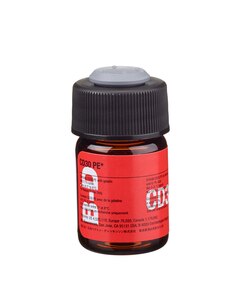Old Browser
This page has been recently translated and is available in French now.
Looks like you're visiting us from {countryName}.
Would you like to stay on the current country site or be switched to your country?


PE Mouse Anti-Human CD30
Regulatory Status Legend
Any use of products other than the permitted use without the express written authorization of Becton, Dickinson and Company is strictly prohibited.
Preparation And Storage
The FITC and PE conjugates are each supplied as 3 μg in 1.0 mL (3 μg/mL) of phosphate-buffered saline (PBS). PBS contains gelatin and 0.1% sodium azide. Store vials at 2° to 8°C. Conjugated forms should not be frozen and should be protected from prolonged exposure to light. Each reagent is stable for the period shown on the bottle label when stored as directed.
CD30, clone Ber-H83, is derived from the hybridization of mouse NS-1 myeloma cells with spleen cells from BALB/c mice immunized with Co cells. CD30 recognizes a 120-kilodalton (kd) type I transmembrane glycoprotein. The CD30 antigen belongs to the tumor necrosis factor receptor/nerve growth factor receptor (TNFR/NGFR) superfamily.

Development References (5)
-
Chiarle R, Podda A, Prolla G, Gong J, Thorbecke GJ, Inghirami G. Molecule of the month: CD30 in normal and neoplastic cells. Clin Immunol. 1999; 90:157-164. (Biology).
-
Dürkop H, Latza U, H S. Schlossman SF, Boumsell L, Gilks W, et al, ed. Leucocyte Typing V: White Cell Differentiation Antigens. New York, NY: Oxford University Press; 1995:1115-1116.
-
Jones DB, Cantarini M, Higginson K, Wright DH. Knapp W, Dörken B, Gilks WR, et al, ed. Leucocyte Typing IV: White Cell Differentiation Antigens. New York, NY: Oxford University Press; 1989:478-479.
-
Schwarting R, Stein H. Knapp W, Dörken B, Gilks WR, et al, ed. Leucocyte Typing IV: White Cell Differentiation Antigens. New York, NY: Oxford University Press; 1989:419-421.
-
Stein H, Mason DY, Gerdes J, et al. The expression of the Hodgkin's disease associated antigen Ki-1 in reactive and neoplastic lymphoid tissue: evidence that Reed-Sternberg cells and histiocytic malignancies are derived from activated lymphoid cells. Blood. 1985; 66:848-858. (Biology).
Please refer to Support Documents for Quality Certificates
Global - Refer to manufacturer's instructions for use and related User Manuals and Technical data sheets before using this products as described
Comparisons, where applicable, are made against older BD Technology, manual methods or are general performance claims. Comparisons are not made against non-BD technologies, unless otherwise noted.
For Research Use Only. Not for use in diagnostic or therapeutic procedures.
Although not required, these products are manufactured in accordance with Good Manufacturing Practices.